The key to growing delicious tomatoes is having well-balanced and the best soil for tomatoes in grow bags. Growers are capable of harvesting the best tomatoes possible due to the nutrients, acidity, and aeration of the soil.
While it may appear that it is a simple task, there is actually considerable effort involved. Don’t worry! In the article, we explain the type of soil, pH level, and depth of soil needed to minimize your search and grow the best tomato plant.
Let’s dive into the details right now!
Contents
Best Soil for Tomatoes in Grow Bags: Quick Comparison
Product: | FoxFarm Ocean Forest FX14000 | Espoma Organic Potting Soil Mix | Black Gold 1302040 |
Photo: | |||
Brand: | FoxFarm | Espoma | Sun Gro |
Style: | Peat Moss, Potting Mix | Potting Mix | Peat Moss, Potting Mix |
Weight: | 25 Pounds | 0.01 Ounces | 5.08 Pounds |
Volume: | 42.5 Liters | 8 Quarts | 8 Quarts |
Organic: | No | Yes | Yes |
pH Level: | 6.3 – 6.8 | 6.0 – 7.0 | 5.5 – 6.5 |
Contents: | Fish Meal, Bat Guano, Earthworm Castings, Crab Kelp Meal | Earthworm Castings, Limestone, Myco-tone | Compost, Earthworm Castings, Forest Humus |
Rating: | |||
Available: |
Best Soil for Tomatoes in Grow Bags: Our Top Picks for Tomato Soils
The potting soils and growing potting mix turned out best because they include chemicals that allow water to flow out yet retain moisture in the soil. Compaction-reducing features were also required.
To prepare the best soil for tomatoes in grow bags, use different potting soil types, which have been supplemented with fertilizers and micronutrients.
Here are the best picks that you are going to love:
1. FoxFarm Ocean Forest Organic Potting Soil FX14000
FoxFarm’s top-tier and best potting soil is a blend of sphagnum peat moss, sandy loam, and forest humus (composed of organic manure bark and other plant residues), making it ideal for use in gardening and a suitable choice for growing tomatoes.
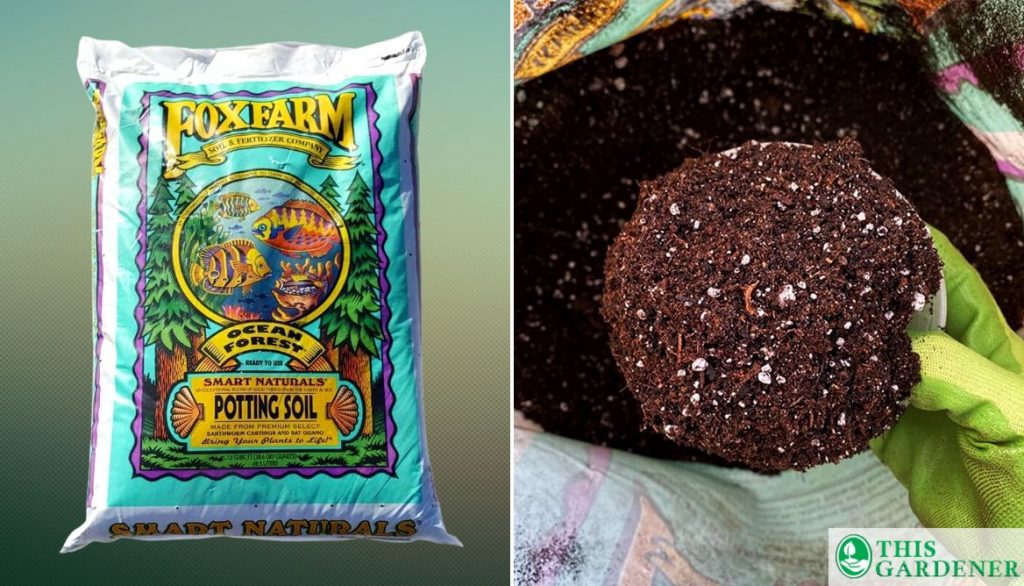
Ingredients: | Sandy loam, forest humus, peat moss |
Organic: | No |
Nutrients: | Fish Meal, bat guano, earthworm castings, and crab kelp meal |
However, a few of the features that distinguish FoxFarm Ocean Forest from other soils are:
- It is developed to prevent compaction over time and to provide adequate drainage throughout watering.
- FoxFarm has been pH-balanced to a range between 6.3 and 6.8; this is ideal for growing tomatoes.
- The blend is not certified organic, however, it is made with all-natural components.
Tomatoes are given an environmental, significant boost right from the start, thanks to adding natural elements like bat guano, fish meal, crab meal, and earthworm castings to the soil mix.
- Good drainage
- Moisture retention is high between waterings
- It comes with naturally added essential nutrients
- Some customers reported that the soil was moldy
2. Miracle-Gro Potting Soil Mix 16 qt.
Cultivate tasty tomato plants without breaking the bank. Seedlings get off to a healthy start with Miracle-Gro Potting Soil Mix because of its combination of perlite, sphagnum peat moss, and coconut coir. The dry peat moss in the potting mix needs a little help from the wetting agent the first time it gets wet, but after that, it soaks up water like a sponge.
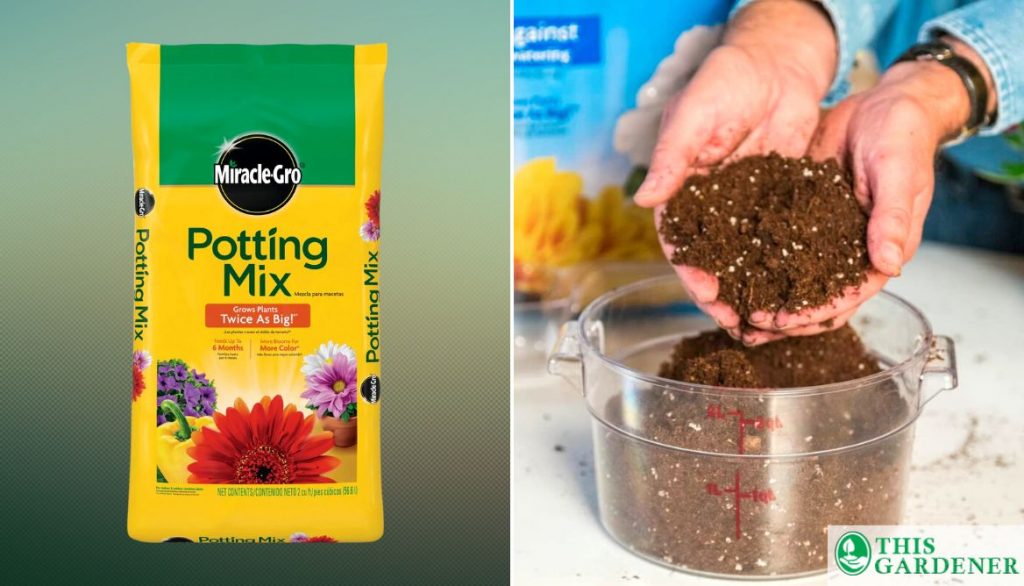
Ingredients: | Peat moss, coco coir, perlite, wetting agent |
Organic: | No |
Nutrients: | Fertilizer |
Fertilizing Time
This Miracle-Gro potting soil mix, like most others from the brand, includes nutrients that stimulate rapid development in young tomato plants delaying the need for additional fertilization for several months.
After that, a high-phosphorus fertilizer designed for growing tomatoes should be periodic. Administered to the container-based best soil for growing tomatoes in grow bags (every 6 weeks or as recommended on the packaging).
- Drainage is Top-Notch
- Moisture is Retained
- Cost-Effective Option
- Fungus gnats found in the soil
3. Organic Potting Soil by Black Gold
For those who are seeking a 100% organic soil blend, Black Gold Potting Soil might be a good choice. This soil has been made without the use of any harmful chemicals, as evidenced by the OMRI seal placed on it.
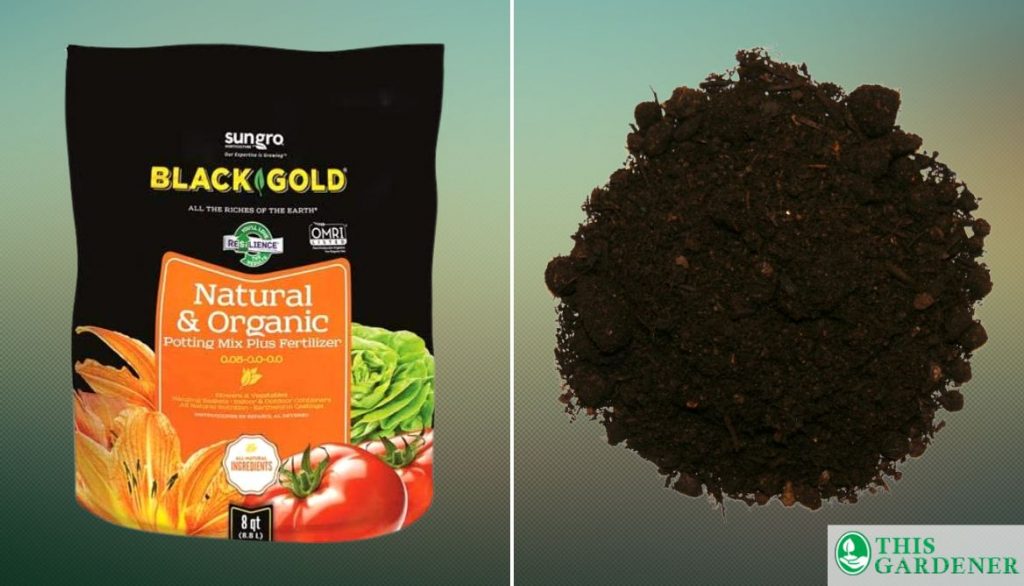
Ingredients: | Peat moss, sandy loam, perlite, pumice |
Organic: | Yes |
Nutrients: | Compost, earthworm castings, forest humus |
Organic Potting Soil has been a standout performer among other soils due to the following features:
- The potting soil mixture is created by mixing rich loam with sphagnum peat moss and then adding pumice and perlite.
- These grains consist of lightweight volcanic rock, and aid drainage while also giving some structural stability to assist ground the roots of tall tomato plants.
The Black Gold potting soil contains a mixture of compost, earthworm castings, and forest humus, in addition to the basic ingredients.
- Organic certified
- Proper drainage
- Moisture retention between waterings
- Natural nutrients are present in the soil
- Slightly heavy on the purse
4. Organic Potting Mix by Espoma
In warm environments, the best soil for tomatoes in grow bags requires constant watering to avoid potential plant death. If you’re worried about forgetting to water your plants, Espoma’s Organic Potting Soil Mix is a safe choice.
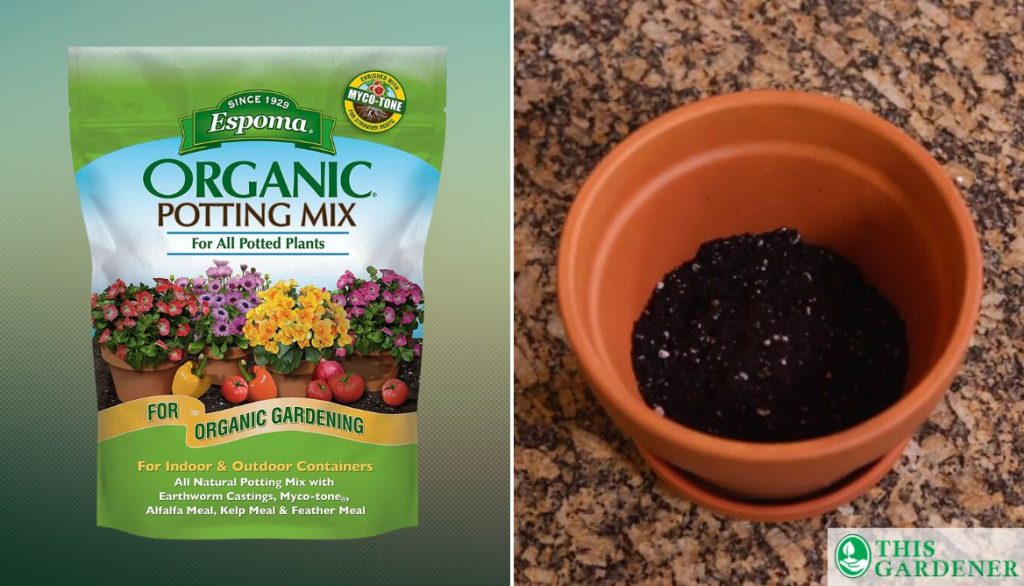
Ingredients: | Peat moss, perlite, humus |
Organic: | Yes |
Nutrients: | Earthworm castings, limestone, Myco-tone (seven species of ectomycorrhizal fungi and four species of endomycorrhizal fungi) |
The company’s unique mycorrhizae (mushroom-based) component combination, Myco-tone, increases water intake in plant roots and mitigates stress caused by dry soil. Tomato plants grown on Espoma’s potting soil have healthier roots and may survive with as much as 30% less water.
Soil Mixture
The potting mix is composed of perlite, sphagnum peat moss, and humus. The combination has been improved with the inclusion of earthworm castings and limestone in addition to a Myco-tone potting mix.
- Drainage is good
- Mushroom-based nutrients are present
- Doesn’t Remain Soggy
- Retain Moisture and keeps the pant fresh
- Some customers reported gnats in the soil
5. Happy Frog Potting Soil by FoxFarm
FoxFarm Happy Frog Potting Soil is the best option for those seeking a premium cultivation mix with supplementary natural nutrients. Composed of equal parts sphagnum peat moss, perlite, and forest humus.
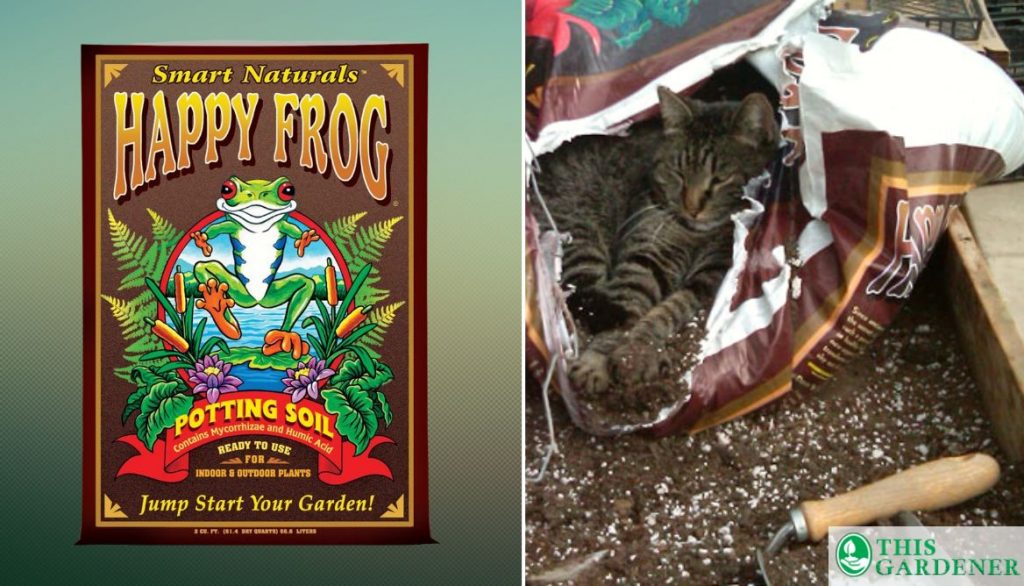
Ingredients: | Forest humus, perlite, peat moss |
Organic: | Yes |
Nutrients: | Micronutrients, including bat guano, humic acid, earthworm castings, ground oyster shells |
These two elements work together to create soil that is both aerated and able to hold enough water to keep the best soil for tomatoes in grow bags healthy between waterings. Tomatoes thrive in the acidic soil environment created by Happy Frog, a growth organic potting mix with a pH of between 6.3 and 6.8.
Nutrients
FoxFarm has increased the nutritional content of the mix by including natural microorganisms and vitamins. The pH of the soil can be adjusted with the use of ground oyster shells and the soil conditioner Leonardite.
Bat guano and worm castings are two components that may be added to the premium potting soil to make it more fertile.
- The soil is rich in Microbes and micronutrients
- Moisture retention is better
- Drainage is optimal
- Small rocks found in some soil bags
How We Chose the Best Soil for Planting Tomatoes
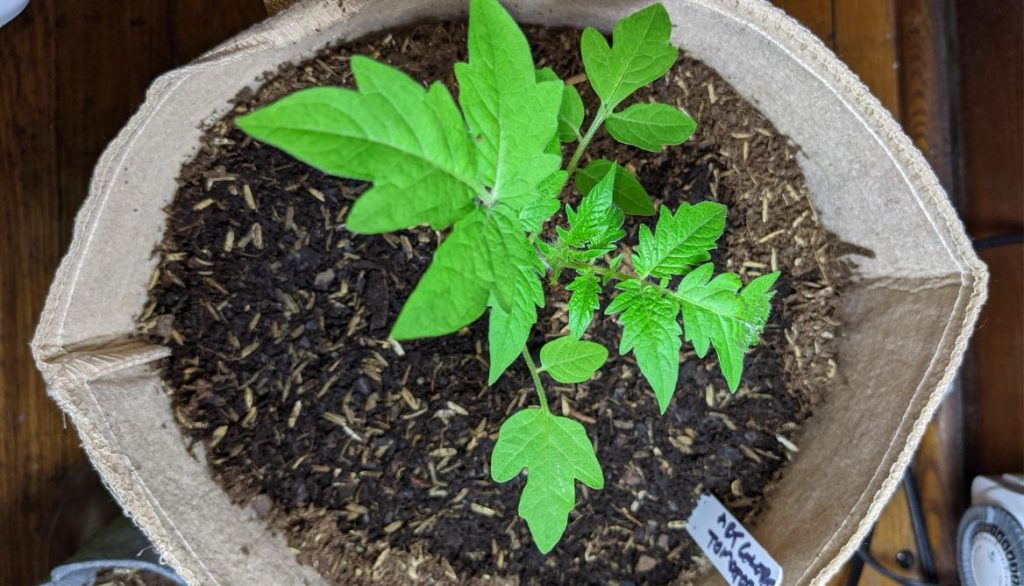
Before selecting the products listed in the article, we tested different potting soil mixtures.
- We filtered out those that did not drain efficiently.
- Restricted our selection to only those items that would not deform with time since the best soil for tomatoes in grow bags dries up so rapidly.
- We also investigated smaller, niche producers with high-quality ingredients and premium mixes.
Additionally, we considered the manufacturer’s reputation in the marketplace, taking into account that well-known names like Miracle-Gro Potting Soil have loyal customers and an established history of success.
Factors to Consider When Selecting the Best Soil for Tomato Plants
Every summer, home gardeners around the country indulge in an unspoken competition to see who can produce the largest, healthiest, and best soil for tomatoes in grow bags.
Some gardeners spend years perfecting the composition of their soil by adding organic matter and compost. But even beginners may get delicious tomatoes if they are planted in the right conditions and in the right potting mix.
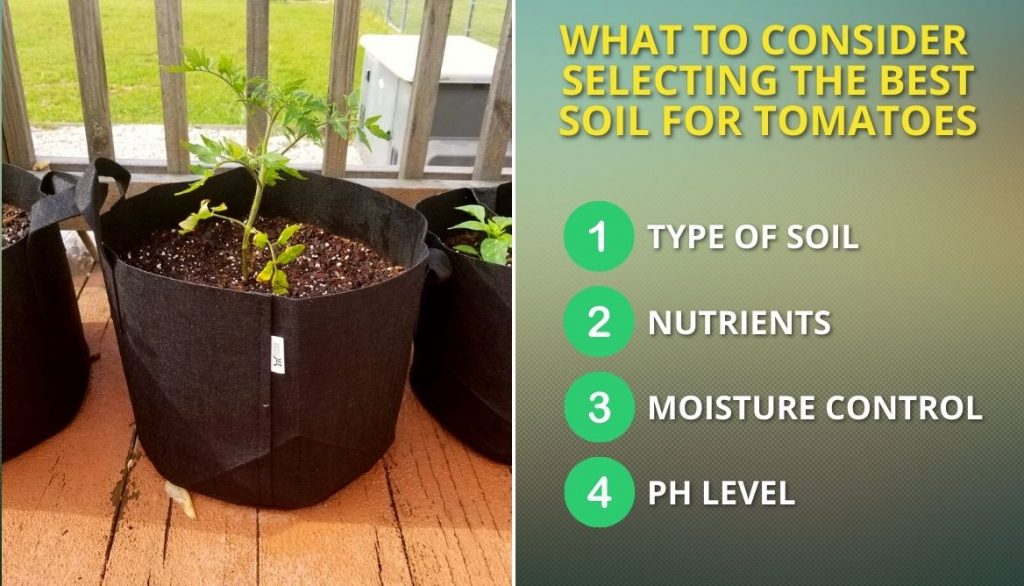
Here’s the checklist you need to consider:
1. Type of Soil
One can grow tomatoes in both, pots or fabric grow bags, as long as the potting soil is suitable. However, most people prefer to plant tomatoes directly in the garden soil or in raised beds. This helps to ensure drainage.
The size of the fabric grow bags can range from 5 to 20 gallons, and they are made of lightweight coated fabric.
Below are a few must-read points when considering the type of soil:
- The soil in containers dries out more swiftly than garden soil
- Using garden dirt to fill containers or grow bags is not a feasible alternative.
Growing in Pots
Growing tomatoes in pots benefit more from a commercial growth organic potting mix because of its bark and coco coir, which prevent the soil from compacting and retaining some moisture. The plain garden soil and raised beds may be improved by adding a quality growth mix.
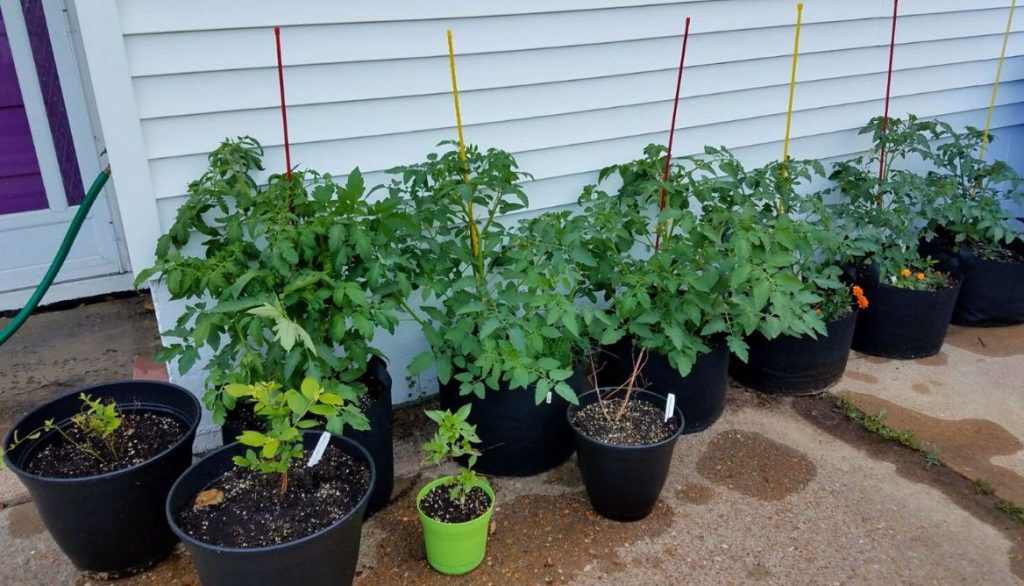
To adjust and improve the drainage of your garden’s current soil, just mix any of these soil additives into the top few inches of soil. Most commercial soil will have at least one of the following elements.
Bark
The bark of pine and fir trees is used to mulch healthy plants and provide a healthy soil environment in which roots can thrive.
Peat Moss
Peat moss is a typical element in growth mixes and is especially useful in tomato and vegetable mixtures because of its capacity to soak water and slowly release it, protecting the plant’s roots from drying out.
Coir
Coconut coir, harvested from the coco nut’s inner shell, prevents soil compaction. It can also help keep roots wet since it absorbs water and then gradually releases it.

Perlite
Perlite, which originates from volcanic glass, keeps soil light and fluffy by breaking up heavily compacted soil.
Sand
If drainage is an issue, ornamental sand can be added to the mixture. It may also strengthen the soil, which is especially helpful for keeping tall tomato plants from tumbling over when their roots spread out.
Wetting Agent
When distributed, some soil mixtures are moist while others are completely dry. Peat moss-containing dry mixes can be difficult to work with when the water is added for the first time since the moss floats instead of absorbing it. After being treated with a wetting chemical, moss may quickly and readily soak in water.
2. Nutrients
The best soil for tomatoes in grow bags flourishes when cultivated in soil that’s high in organic matter and has been amended with a variety of minerals and micronutrients including phosphate, potassium, calcium, magnesium, and potash.
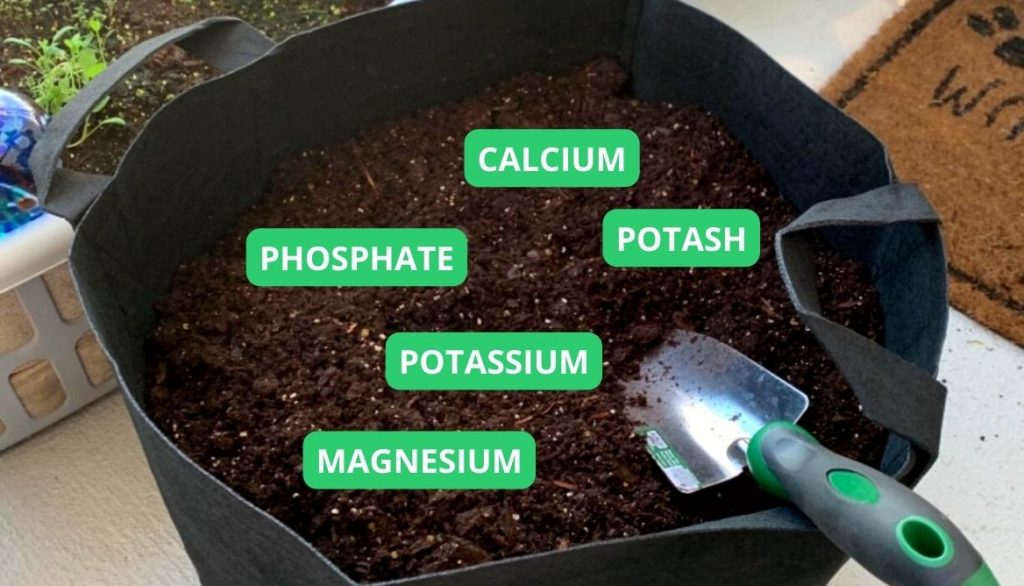
Middle Numbers
The middle number in a fertilizer’s nitrogen (N), phosphorus (P), and potassium (K) ratio indicates how high the product is in phosphorus, which is ideal for growing tomatoes. To enhance tomato growth, look for an NPK ratio of 5-7-3 or 8-15-6 in your tomato fertilizer.
However, the ratio may change from one product to the next relying on whether or not the fertilizer is made specifically for tomatoes or is marketed for use with a wider variety of plants.
Synthetic Nutrients
It’s not uncommon to find natural or synthetic nutrients in certain growth mixtures and not others. If you’re growing tomatoes in a container, you may want to give them a dose of tomato fertilizer every six weeks or so, even if your soil mix already contains fertilizer.
Why is that?
The best soil for tomatoes in grow bags requires a lot of nutrients, but the dirt in a container washes away those nutrients more quickly than the garden soil.
To find out how long you should wait before beginning a regular fertilizing schedule, read the instructions on the back of your bag of potting soil.
3. Moisture Control
Water is great for the best soil for tomatoes in grow bags, but they can’t be grown in pools of it. Tomato plants that are grown in containers that don’t drain properly often suffer from root rot and ultimately fail. Tomatoes require soil that drains well yet stays wet (not soggy) for healthy root development.
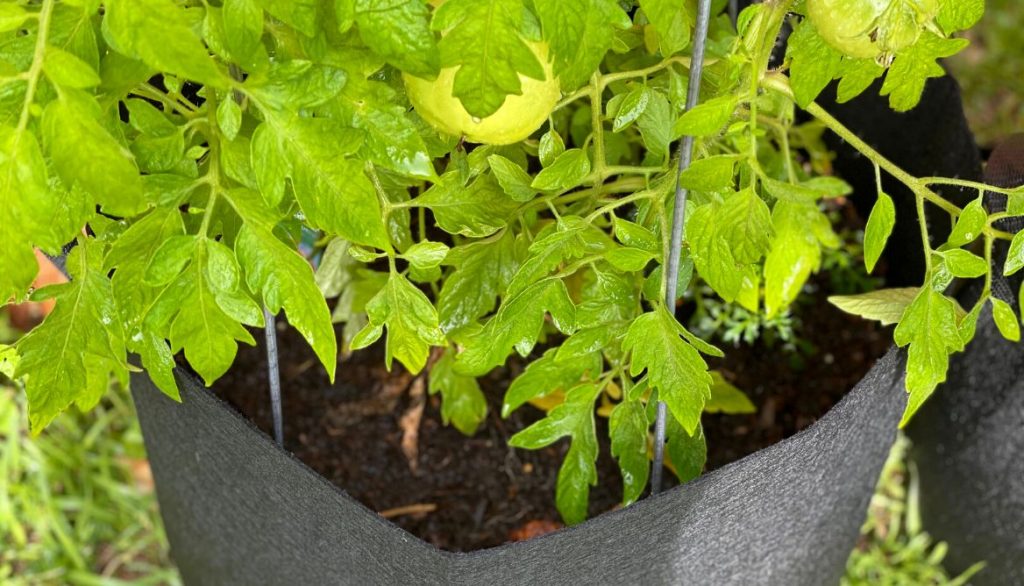
The drainage properties of peat moss and the water-holding capacity of coco coir are similar. Both prevent the soil from becoming too compact, which is essential for the healthy development of tomato roots.
Recommended Watering
Tomato plants in the garden require 1–2 inches of water each week, which might require daily irrigation. Because soil dries up more rapidly in containers, especially during warmer weather, daily watering may be beneficial for tomato plants.
4. pH Level
Tomatoes bloom in conditions ranging from neutral to slightly acidic soil pH.
- The neutral point of the pH scale is 7, however, the range goes from 0 to 14.
- The more negative the number is, the more acidic it is, and the higher the number, the more alkaline it is.
- A soil pH of 6.5 to 7.0 is preferred.
- Extensive composting or the addition of a lot of dry leaves to the soil typically puts it in that area.
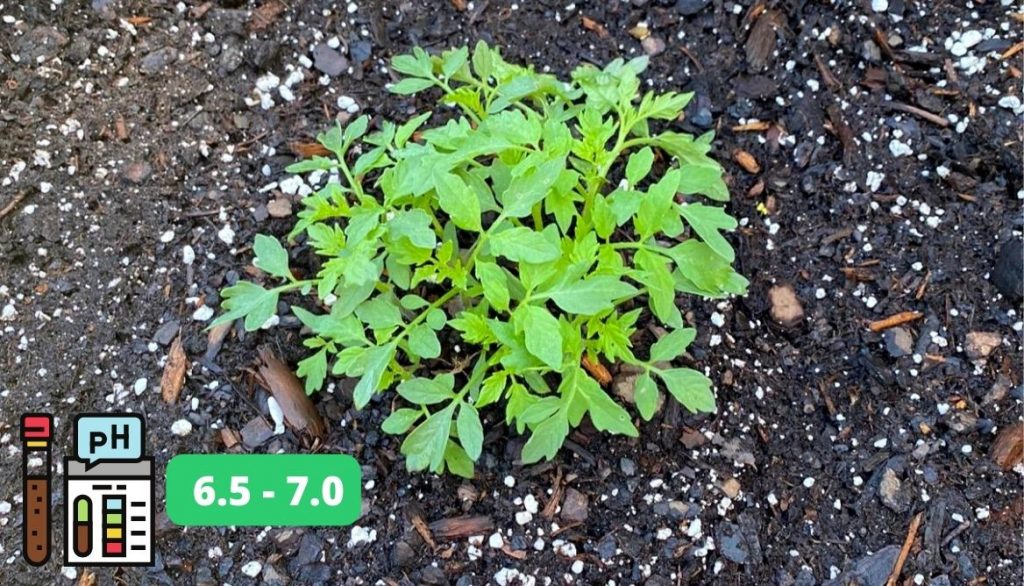
Soil that is high in clay may be overly alkaline, which stunts tomato development.
Determining the pH of Soil
Not all store-bought potting soils include information on the pH level of the product. A soil tester can be purchased for very little money at any garden shop and is all you need to determine the pH of your soil.
Ideal Depth of Soil for Tomato Plant
Tomato roots do not penetrate very far; instead, they sprout rather than sink. Within the top inch of the soil, a tomato plant’s healthy root system exists. Grow tomatoes do well in soil that is 8 to 12 inches deep. Before moving the tomato plants, remember to loose soil with a trowel according to the ideal depth.
Tips for Growing Tomatoes in Grow Bags
Here are some of the best tips for planting tomatoes in grow bags:
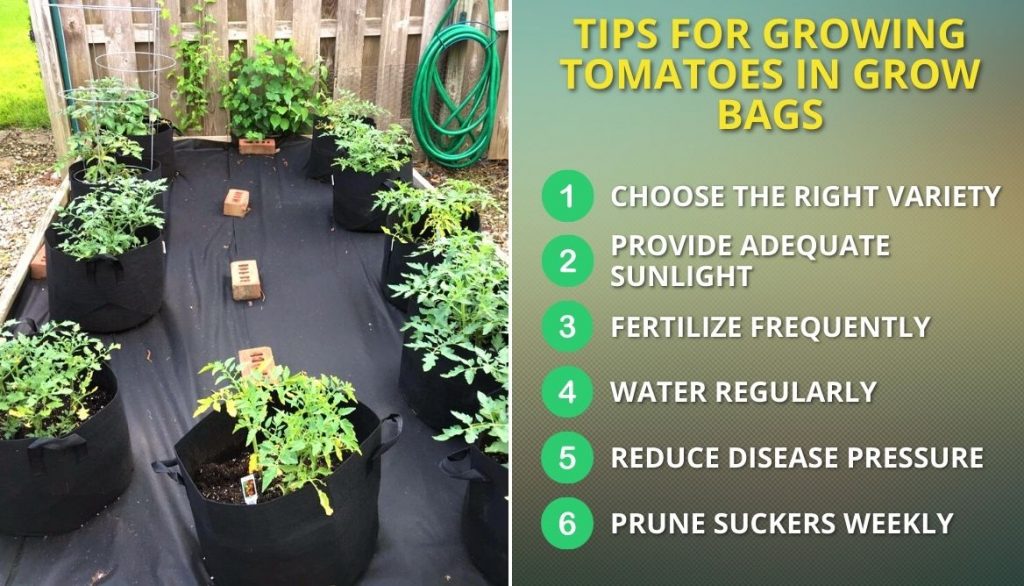
1. Choose the Right Variety
You may divide the best soil for tomatoes in grow bags into two broad categories: determinate and indeterminate.
Determinate
Tomatoes with a determinate growth habit produce more of a bush than a vine. Therefore, these types will be less prone to spreading and falling over, and more compact overall.
- Deep Purple F1 Regal Plum Tomato (75 days to maturity)
- Iron Lady F1 Tomato (75 days to maturity)
- Merit F1 Mountain Tomato (75 days to maturity)
- A Belstar Tomato (65 days to maturity)
Indeterminate
Although indeterminate potted tomatoes produce extensively, they have a tendency to outgrow their allotted area. Keeping them in check requires constant work with trimming, training, and trellising. Tomatoes with an indeterminate growth habit are better off grown in the ground rather than in grow bags.
2. Provide Adequate Sunlight
In order to flourish and provide many blooms, tomato plants require enough direct sunshine. You should put your grow bags in the sunniest spot you can find close to your house. This spot should get at least 8 hours of sunlight every day.
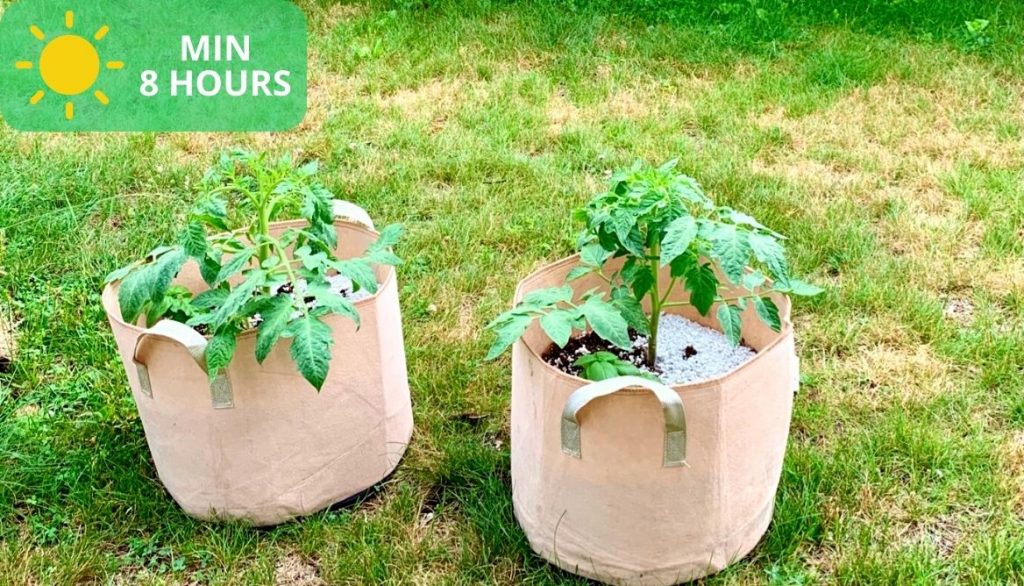
3. Fertilize Frequently
Once potted tomatoes begin to produce fruit, they require a lot of food. Apply organic fertilizer at regular intervals of two to three weeks. We ourselves are big fans of organic fish emulsions. It stinks, but it accomplishes its purpose!
Neptune’s Harvest 36-Oz Bottle of Organic Fish Fertilizer
This fertilizer is made from naturally occurring enzymes found in fresh North Atlantic fish. It is an organic fertilizer, high in nutrients, and provides a protein source for plants.
Beneficial bacteria thrive in the presence of this molecule, and its slow breakdown into basic compounds makes it ideal for use in soil amendments.
4. Water Regularly
Since organic potting soil is porous and lightweight, we will need to water it often. Daily watering is required in the absence of predicted rainfall. Extreme heat calls for twice-daily watering to keep the roots at a comfortable temperature.
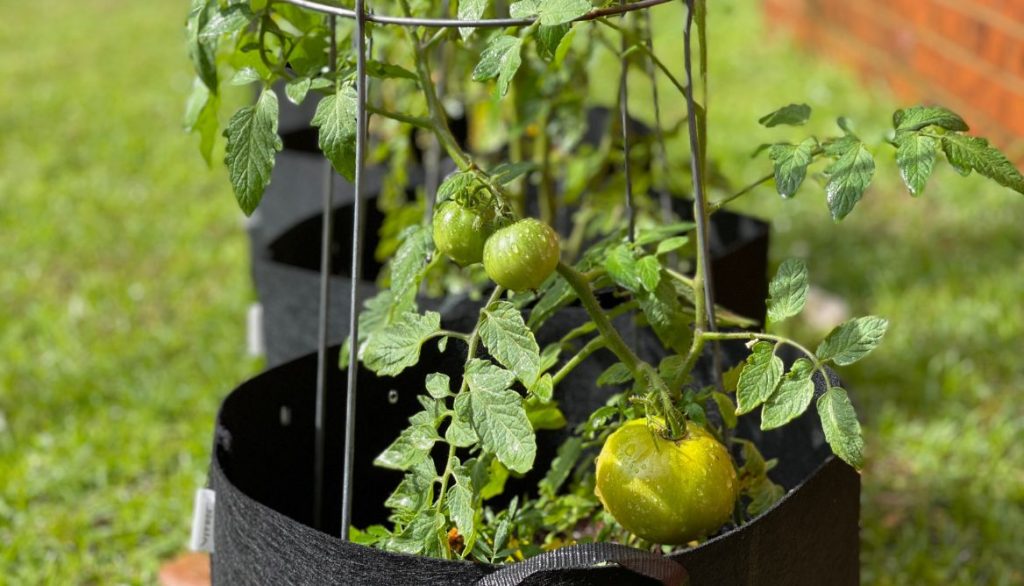
The top few inches of your grow bags will benefit from a layer of organic mulch. A drip irrigation system is a godsend for people who are constantly on the go or who work long hours.
5. Reduce Disease Pressure
Early blight is a soil-borne disease that can severely damage tomato plants. To avoid this, consider doing the following:
- Use sharp, clean garden shears or scissors to remove any branches that are resting on the ground.
- Aerating the ground rather than the leaves is an effective method of disease prevention
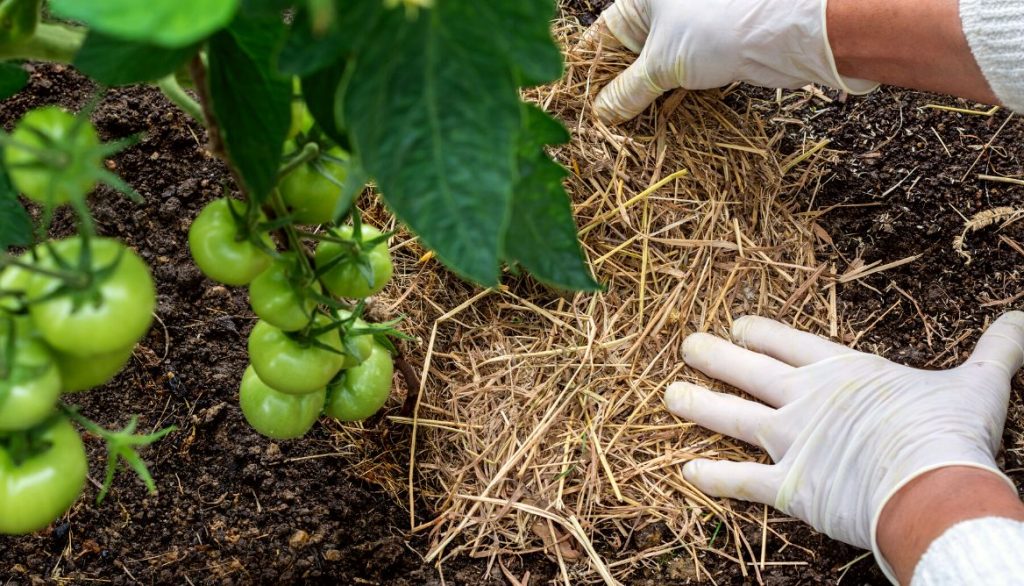
Finally, resting some mulch on the soil’s surface helps prevent a lot of the splashing that causes damage to plant leaves. Read our take on this:
- We rather prefer the idea of using organic straw sourced from a nearby farm.
- You may buy natural wood chips, or do what we do and cut your own firewood.
Look into the products listed below if you don’t have access to the above solutions.
Organic Hardwood Composted Bark Mulch
When utilizing grow bags, this organic hardwood composted bark mulch is a fantastic, natural solution for retaining moisture and reducing illness. To the top of each organic potting mix bag, add two inches of soil.
Double F Farms Premium Organic 100% Natural Straw
Wheat straw that is premium organic and all-natural is ideal for mulching grow bags and other garden areas. To the top of each growth bag, add a 2″ layer.
6. Prune Suckers Weekly
Tomatoes are fast-developing plants, but not all of their growth is beneficial. The new branches that tomato plants sprout are called “suckers,” and they won’t bloom or bear fruit. They will crowd out the productive stems and “suck” nutrients from the plant if they are allowed to remain.
Keep an eye out for the suckers that develop in the space between the main stem and the leaf crotches. If caught in time, you can simply remove them with your fingertips.
Our Verdict
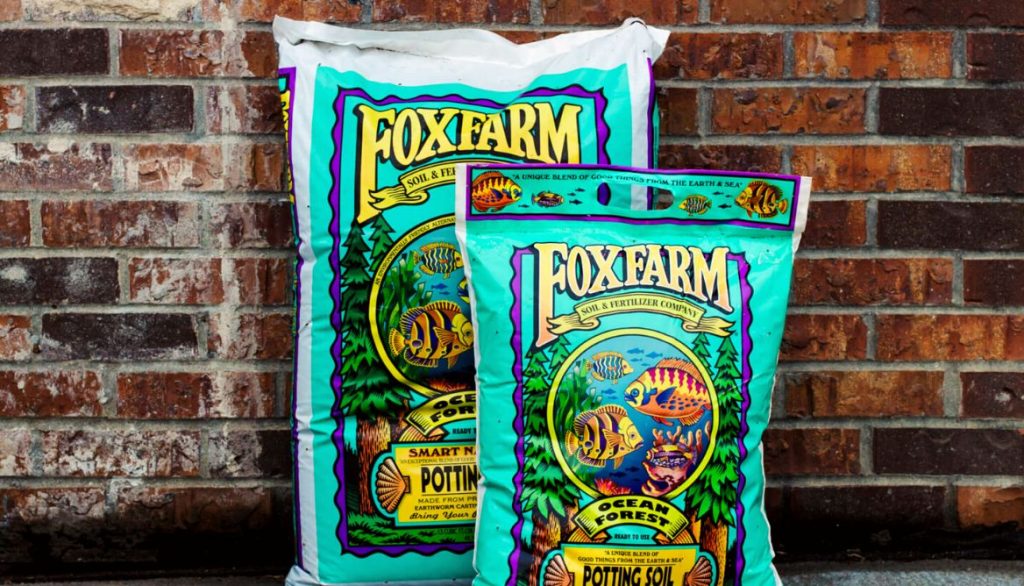
The best potting mix soil for tomatoes should be well-draining soil slightly acidic to a neutral pH level. It should contain rich organic nutrients that are beneficial for growing tomatoes. Out of all the products, our personal favorite is FoxFarm’s soil due to the following reasons:
- High-quality
- Can be used as an all-purpose soil mix
- Lightweight
- Drains well
- Optimal growth
- Takes the ideal amount of water
However, it’s important to avoid heavy clay soils, as these can retain too much moisture and lead to root rot.
FAQ
What is the best soil mix for tomatoes?
The best soil mix for tomatoes should contain micro and macro nutrients including phosphorus, potassium, calcium, and magnesium for a healthy potting mix. They thrive at a soil pH of 5.8 to 7.0, which is ideal for most garden vegetables, and in a nutrient-rich, sandy loam with good drainage.
Can you grow tomatoes in a bag of soil?
Yes, you can grow tomatoes in a bag of soil. It is a fantastic approach to tomato cultivation and getting started with home gardening. Though similar to growing in pots or the ground, growing tomatoes in bags have several unique advantages.
Do tomatoes grow well in grow bags?
Yes! They do grow well in grow bags but to a certain extent! It all depends on how often they are watered and whether or not they have enough room to grow and sunlight. A garden-grown tomato plant may outperform one of these, but only slightly.
What will make tomatoes grow faster?
The thing that will make tomatoes grow faster is the best soil for tomatoes in grows bags. They prefer warm soil, as it encourages quicker results. Mulch should be removed from garden beds in the early spring so that soil can absorb the sun’s warmth. Covering the mattress with a sheet of transparent plastic will also work.
How do you increase tomato fruiting?
A leaf area index of 3 increases fruit development. Hand-thinning tomatoes on clusters produce bigger, more uniform fruit. Auxins at anthesis can boost fruit set and size, especially under low light and temperature circumstances.
Conclusion
We hope that this article has been the most beneficial one for you. As you can see that growing a tomato plant is not easy and there are many factors involved. Always look to fertilize the plants frequently to avoid any hassle.
Have you ever grown a tomato plant before? Which soil did you use before? Share your experience with us in the comment section below as we would love to hear your point of view regarding the best soil for tomatoes in grow bags!
- How to Get Potatoes to Sprout Eyes: Detailed Growing Guide with 3 Options - July 31, 2023
- Weight of a Medium Potato: Revealed in Detailed Guide - July 29, 2023
- Maris Piper Potatoes: 9 Substitutes You Should Know About - July 27, 2023
Hello! I’m Jessica Zander, a garden coach and consultant based in the Boston area (zone 6b), offering virtual consultations across the country and Canada.
I’ve been passionate about gardening since the early 1990s, and in 2022, I launched You Can Do It Gardening to empower individuals to feel more confident in their gardening endeavors.
Following a 30-year career in nonprofit finance and operations, I transitioned out of that field in mid-June of 2023 due to the growing demand for coaching services. Interestingly, my years of presenting financial statements to boards and finance committees proved to be valuable experience for teaching people about gardening! I enjoy sharing skills, providing guidance and suggestions, and collaborating efficiently with clients to make significant improvements to their outdoor spaces, both small and large. I also regularly teach at the Arlington Continuing Education and Cambridge Adult Education.
My approach is direct and practical, akin to Mary Poppins, but tailored to your garden. Clients find satisfaction in saving money and taking pride in their own gardening achievements.

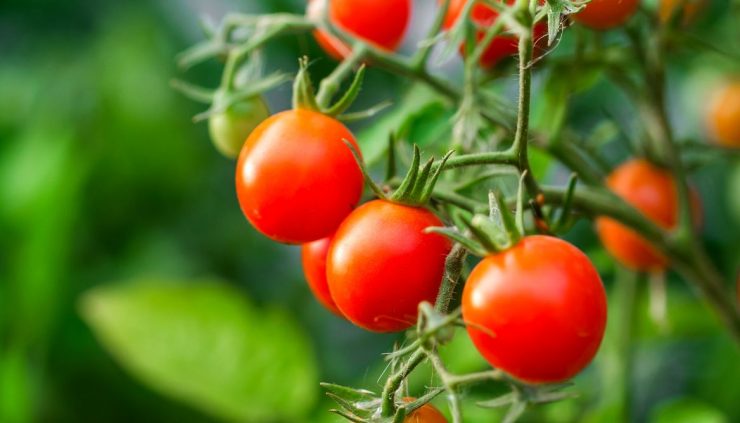



Add comment